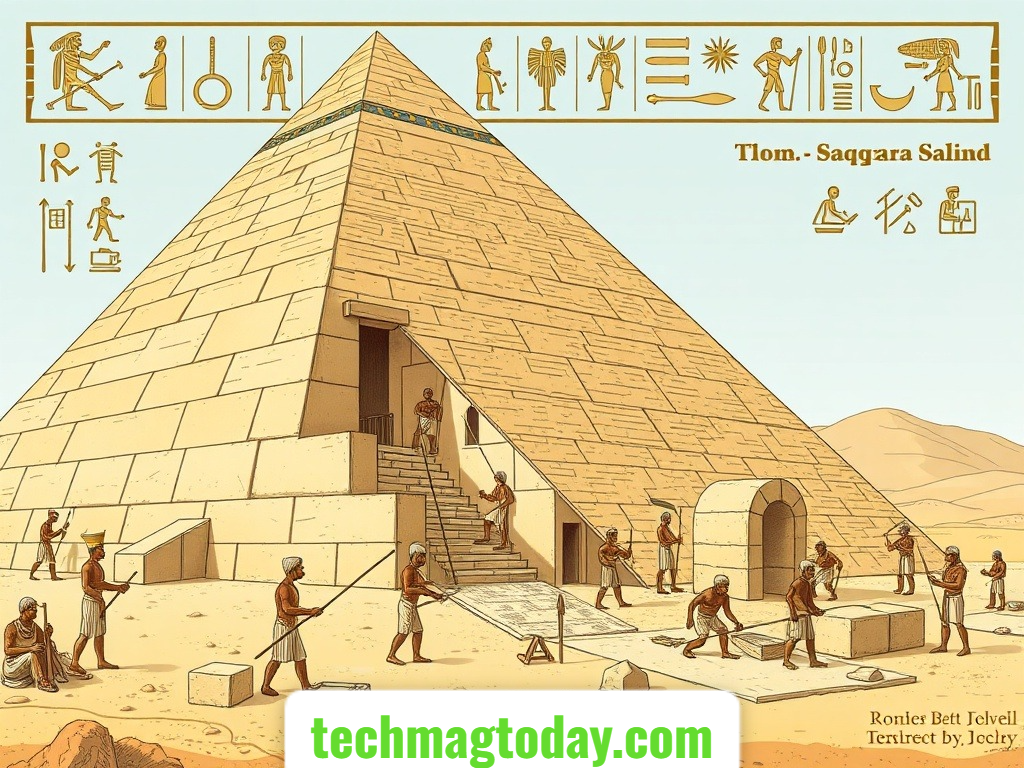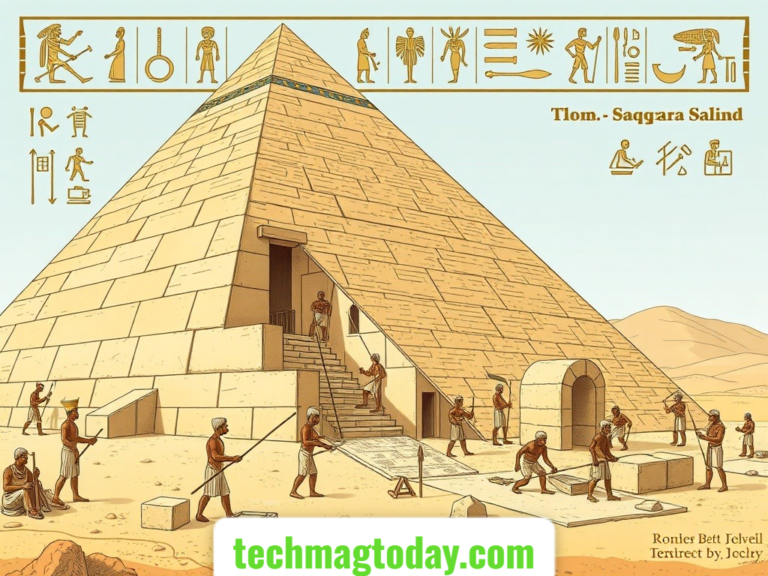
Introduction
The Saqqara Pyramid, also known as the Step Pyramid of Djoser, marks a revolutionary chapter in ancient Egypt’s architectural history. Located in the Saqqara necropolis near Memphis, this pyramid is the earliest large-scale cut-stone structure in human history. Built over 4,700 years ago during Egypt’s Third Dynasty, it represents a massive leap from traditional mastaba tombs to complex monumental pyramids. What fascinates researchers and engineers alike is the Saqqara Pyramid construction technology—a blend of ingenuity, experimentation, and sacred symbolism. In this article, we’ll explore the intricate techniques, tools, and logistics behind this legendary marvel, using historical, archaeological, and architectural insights.
The Historical Significance of the Saqqara Pyramid
A Monument of Innovation
The Saqqara Pyramid wasn’t just another tomb—it was an experimental leap forward. Commissioned by Pharaoh Djoser and designed by his chief architect Imhotep, it introduced vertical architectural ambition in Egyptian culture. Instead of a flat-topped mastaba, it featured six stacked layers, gradually reducing in size—hence the term “step pyramid.”
A Precursor to the Giza Pyramids
Many techniques that would later be perfected at Giza first originated at Saqqara. For example:
- The use of limestone casing.
- Construction alignment with the cardinal points.
- Deep underground burial shafts.
By understanding Saqqara Pyramid construction technology, we gain insight into how the Egyptians honed their skills for later pyramid masterpieces.
Materials Used in Construction
Local Limestone as Core Material
The core of the Saqqara Pyramid was made using locally quarried Tura limestone, an abundant material near Memphis. These stones were roughly cut and laid in horizontal courses.
Stone vs. Mudbrick Comparison
| Material | Used At Saqqara? | Benefits | Drawbacks |
| Mudbrick | No | Easy to mold and cheap | Poor durability |
| Local Limestone | Yes | Weather-resistant, stronger | Difficult to transport |
| Granite | Minimal use | High strength | Very heavy and rare |
The decision to use limestone helped ensure the pyramid’s durability across millennia, unlike earlier mastabas which crumbled with time.
Tools and Labor Used in Pyramid Construction
Tools Available to Ancient Egyptians
Though bronze tools existed, copper chisels were predominantly used for quarrying and shaping limestone. Other tools included:
- Wooden sledges for transport
- Dolerite pounding stones
- Ropes, levers, and rollers
Labor Organization
According to Egyptologists, pyramid construction didn’t rely solely on slave labor. Instead, well-fed and skilled workers organized into seasonal crews likely completed the job.
Workforce Estimations
| Workforce Type | Estimated Number | Responsibilities |
| Skilled Stoneworkers | 500–1,000 | Quarrying and carving |
| Haulers & Transporters | 2,000–3,000 | Moving stones and materials |
| Supervisors & Engineers | 100–200 | Managing design and logistics |
Saqqara Pyramid Construction Technology Explained
Step-by-Step Building Process
- Foundation Preparation: The bedrock was leveled and carved to serve as a solid base.
- Mastaba Phase: Initially, a square mastaba was built using small limestone blocks.
- Stacking Technique: Subsequent mastabas were stacked atop one another to form steps.
- Core Construction: Filled with rough stone rubble, then faced with well-cut limestone.
- Casing Stones: Finer limestone was used to cover and stabilize the structure.
This was the first time large stone blocks were laid with architectural precision, using vertical shafts and internal corridors.
Load-Bearing Techniques
The pyramid’s stepped design wasn’t just aesthetic. It dispersed weight downward and reduced structural stress. This foundational concept evolved into smooth-sided pyramids later on.
Orientation and Alignment Techniques
Astronomical Precision
The pyramid’s orientation—aligned to the cardinal points—suggests the use of astrolabes or star charts. Ancient Egyptians may have Saqqara Pyramid construction technology tracked the North Star or used a plumb bob method with shadows to calibrate directions.
Sacred Geometry and Symbolism
The number six (layers in the pyramid) and the pyramid’s proportions correlate with Egyptian numerology and cosmology. The form symbolized ascending to the heavens, a divine ladder for the king’s soul.
Logistics and Transportation Technology
Moving Massive Stones Without Wheels
The Egyptians lacked the wheel during Djoser’s reign. So how did they move blocks weighing 1–3 tons?
- Sledges lubricated with water to reduce friction on sand.
- Inclined ramps to elevate stones vertically.
- Wooden rollers (though debated by some historians).
Internal Ramp Theories
While external ramps are commonly discussed, some experts propose internal spiral ramps built within the pyramid’s structure—although this is more applicable to later pyramids like the Great Pyramid.
Architectural Features of the Complex
More Than Just a Pyramid
The Saqqara complex was Egypt’s first large-scale enclosed funerary structure. It included:
- Mortuary temple
- Serdab chamber (housing a statue of Djoser)
- Underground galleries and shaft tombs
Innovative Security Design
The underground network featured narrow passages and decoy doors to deter tomb robbers. The central burial shaft plunged over 90 feet into the bedrock.
Comparisons with Other Ancient Constructions
| Structure | Era | Material Used | Construction Complexity |
| Saqqara Step Pyramid | 27th century BCE | Limestone | Medium to High |
| Giza Pyramids | 26th century BCE | Limestone & Granite | High |
| Mesopotamian Ziggurats | 21st century BCE | Mudbrick | Low to Medium |
Unlike Mesopotamian ziggurats, which were built from mudbrick, Saqqara’s stone structure gave it unmatched longevity.
Imhotep: The Mind Behind the Pyramid
First Named Architect in History
Imhotep wasn’t just an architect; he was also a priest, healer, and astronomer. His vision of transforming burial mounds into multi-layered stone structures changed architectural history.
Legacy and Deification
Imhotep’s innovations were so influential that he was later deified as the god of wisdom and medicine. Without his breakthroughs, the evolution of Egyptian pyramid construction might have taken an entirely different path.
Modern Studies and Archaeological Technologies
Recent Discoveries at Saqqara
- In 2020, a team discovered sealed coffins and artifacts near the Djoser Pyramid, using ground-penetrating radar (GPR).
- Restorations using 3D scanning have revealed hidden corridors and unfinished chambers, offering clues about experimental construction stages.
Saqqara’s Use in AI and Digital Preservation
- Modern scholars are applying machine learning to analyze stone layouts and chisel patterns.
- 3D reconstruction helps simulate construction techniques to test their feasibility in real-world conditions.
Step Pyramid vs. Smooth Pyramid
| Feature | Step Pyramid (Saqqara) | Smooth Pyramid (Giza) |
| Surface | Stepped | Smooth |
| Purpose | Funerary | Funerary |
| Material | Limestone | Limestone + Granite |
| Construction Method | Stacking Mastabas | Core + Casing with ramps |
| Designer | Imhotep | Hemiunu (Giza) |
Conclusion
The Saqqara Pyramid construction technology stands as a monumental achievement in the history of human engineering. Imhotep’s revolutionary use of stone masonry, load distribution, and celestial alignment turned a simple mastaba into an enduring symbol of innovation and ambition. This ancient marvel not only redefined architectural possibilities in its era but also laid the foundational blueprint for all subsequent Egyptian pyramids. With modern archaeological tools now revealing more than ever before, the Saqqara Pyramid continues to educate, inspire, and astonish, bridging ancient wisdom with modern curiosity.
FAQs About Saqqara Pyramid Construction Technology
1. What tools were used to build the Saqqara Pyramid?
Copper chisels, dolerite pounding stones, sledges, levers, and ramps were commonly used tools for construction.
2. How was the Saqqara Pyramid aligned so precisely?
Egyptians likely used astronomical observations, such as tracking the North Star or using shadow-based methods, to align the structure.
3. Who was Imhotep and why is he significant?
Imhotep was the chief architect of the Saqqara Pyramid. He is known as the first recorded engineer and was later worshipped as a deity.
4. What makes Saqqara different from Giza Pyramids?
Saqqara was the first step pyramid and used smaller, stacked layers, while Giza features smooth-sided pyramids with advanced techniques.
5. Is the Saqqara Pyramid open to visitors today?
Yes, after years of restoration, the Saqqara Pyramid and its underground chambers are now open for public visits.




